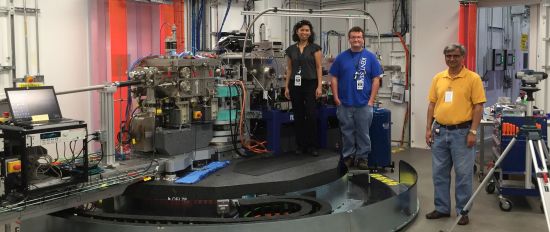X-ray Specs
UAlbany Part of First Team to Use High-Energy Beamline to Study Molecular Vibrations
 |
|
Associate Vice President for Research Satyendra Kumar, right, worked with his post doctorate associate Deña M. Agra-Kooijman, left, and PhD student Lewis Sharpnack at the Brookhaven National Laboratory. |
ALBANY, N.Y. (June 19, 2017) — Satyendra Kumar, UAlbany’s associate vice president for Research and a professor of Physics, was part of a team of researchers that studied a new way to track dynamic molecular features in soft materials, including the high-frequency molecular vibrations that transmit waves of heat, sound and other forms of energy.
Deeper understanding of the propagation of these forms of energy in soft materials, such as polymers, biomaterials or liquid crystal compounds could lead to a range of energy-inspired innovations — from thermal and acoustic insulators, to ways to convert waste heat into electricity.
The team, which used the state-of-the-art inelastic X-ray scattering (IXS) beamline developed by researchers at the National Synchrotron Light Source II (NSLS-II) of Brookhaven National Laboratory, was led by Brookhaven physicist Dima Bolmatov.
Kumar, who came to UAlbany a year ago from Kent State University, participated in the research along with members of his Kent State research team: PhD student Lewis Sharpnack and postdoctoral associate Deña M. Agra-Kooijman.
The team published the first research describing the use of the IXS beamline to monitor the propagation of vibrations through a liquid crystalline material in three different phases. Their findings, published on May 26 in Nano Letters, show that the nanoscale structural reorganization caused by changes in temperature — as the system becomes less ordered — dramatically disrupt the flow of vibrational waves. The findings show that change of the “phase,” could be used to control the vibrations and the flow of energy.
“This research was not possible before because the X-ray experiments lacked the required energy resolution until now,” Kumar said. “Our results have not only established the enormous utility of the IXS beamline, but also opened the door to probing dynamics of soft materials in an unprecedented manner.”
The ability to track such fast dynamic properties would not be possible without the unique capabilities of NSLS-II, a DOE Office of Science User Facility at Brookhaven Lab. NSLS-II produces extremely brilliant beams of high-energy X-rays for studies in a wide range of scientific fields. At the IXS beamline, scientists bombard samples with X-rays and measure the energy they give up or gain very precisely – by better than one part-per-million precision – as well as the very small angle at which they scatter off the sample.
The technique could also be used to study dynamic processes in other soft systems such as biological membranes or any kind of complex fluid.
“We could look at how the lipid molecules in a cell membrane cooperate with each other to create tiny porous regions where even smaller molecules, like oxygen or carbon dioxide, can pass through — to see how gas exchange operates in gills and lungs,” Bolmatov said.
“The energy exchange tells us how much energy it took to make some molecules vibrate in a wave-like motion. The scattering angle probes the vibrations propagating over different length scales inside the sample — from nearly a single molecule to tens of nanometers. The new IXS beamline at NSLS-II can resolve those length scales with unprecedented precision,” said Yong Cai, the lead scientist of the IXS beamline.
In the liquid crystal study, the scientists made measurements at three different temperatures as the material went from a crystal to a less-ordered liquid crystal state, and finally an ordinary fluid state. Changing the material properties can control the way energy moves through the material, and those changes can be achieved by changing the temperature, as was done in this experiment, or by applying external electric or magnetic fields.
This paves the way for new so-called phononic or optomechanical applications, where sound or light is coupled with the mechanical vibrations. Such coupling makes it possible to control a device by applying external light and sound or vice versa.
“We’re all familiar with applications using the optical properties of liquid crystals in display screens,” Bolmatov said. “We’ve found new properties that can be controlled or manipulated for new kinds of applications.”
“The IXS beamline is also now opened to external users — including scientists interested in these and other soft materials and biological processes,” said Cai.
The research team also included Mikhail Zhernenkov, Alexey Suvorov, Ronald Pindak, and Alessandro Cunsolo of NSLS-II. This construction of the IXS beamline was supported by the DOE Office of Science. A grant from the US-Ireland Research and Development Partnership program of the National Science Foundation facilitated the participation of Kent State and UAlbany researchers in the study.
![]() For more news, subscribe to UAlbany's RSS headline feeds
For more news, subscribe to UAlbany's RSS headline feeds
A comprehensive public research university, the University at Albany-SUNY offers more than 120 undergraduate majors and minors and 125 master's, doctoral and graduate certificate programs. UAlbany is a leader among all New York State colleges and universities in such diverse fields as atmospheric and environmental sciences, business, education, public health,health sciences, criminal justice, emergency preparedness, engineering and applied sciences, informatics, public administration, social welfare and sociology, taught by an extensive roster of faculty experts. It also offers expanded academic and research opportunities for students through an affiliation with Albany Law School. With a curriculum enhanced by 600 study-abroad opportunities, UAlbany launches great careers.


